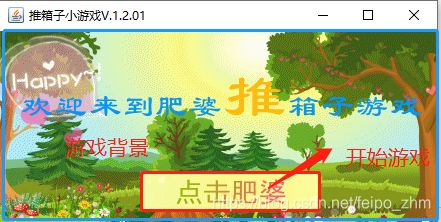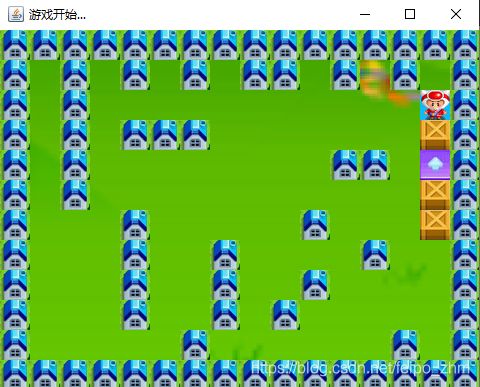使用java制作小游戏-简易推箱子
我会将源码贴出,并告诉大家代码的大致走向以及核心算法。
告诉大家我目前使用的编译环境是:JDK1.8
使用的编程软件是:VScode , 经过我的测试,大家一样可以使用eclipse 和 MyEclipse这两个软件进行正常的运行。
首先,贴出主程序入口,唯一的mian方法:
package Number;
public class TXZ {
public static void main(String[] args){
//new Successed();
new Welcome(); //主入口
//new MainFrame();
}
}
package是工程包,你可以按照实际情况。TXZ是我随意取得名字,大家按照java的编程风格来就好,别学我的,会被人打死。
第二步:进入Welcome程序
先贴出效果图给大家看看,游戏的启动界面。
贴出Welcome程序:
package Number;
import java.applet.Applet;
import java.applet.AudioClip;
import java.awt.Button;
import java.awt.Container;
import java.awt.Font;
import java.awt.event.ActionEvent;
import java.awt.event.ActionListener;
import java.io.File;
import java.net.URI;
import java.net.URL;
import javax.swing.Icon;
import javax.swing.ImageIcon;
import javax.swing.JButton;
import javax.swing.JFrame;
import javax.swing.JLabel;
import javax.swing.JTextArea;
import javax.swing.WindowConstants;
public class Welcome extends JFrame implements ActionListener {
public Welcome() {
addButton(); //
setBackground();
setFrame();
}
private void addButton() {
Icon icon2 = new ImageIcon("image/dianji.gif");
JButton btn = new JButton(icon2);
btn.setIcon(icon2);
btn.setBounds(140, 140, 180, 38);
this.add(icon2);
btn.setFont(new Font("Serif", Font.BOLD, 20));
btn.setLocation(140, 140);
btn.setSize(180,40);
btn.addActionListener(this);
this.add(btn);
this.setDefaultCloseOperation(JFrame.EXIT_ON_CLOSE);
}
private void stopSound() {
// Icon icon = new ImageIcon("image/stop.jpg");
// JButton btn1 = new JButton(icon);
// btn1.setBounds(400, 20, 30,30);
//
// // btn1.setBackground(Color.GREEN);
// btn1.addActionListener(this);
// this.add(btn1);
Icon icon1 = new ImageIcon("image/stop.jpj");
JButton btn = new JButton(icon1);
btn.setIcon(icon1);
btn.setBounds(400, 20, 30,30);
this.add(icon1);
btn.setLocation(140, 140);
btn.setSize(180,40);
btn.addActionListener(this);
this.add(btn);
}
private void add(Icon icon2) {
// TODO Auto-generated method stub
}
private void setBackground() {
Icon icon = new ImageIcon("image/Jogin.gif");
JLabel jlable = new JLabel(icon);
jlable.setBounds(0, 0, 450, 225);
this.add(jlable);
}
private void setFrame() {
this.setLayout(null);
this.setLocation(550, 250);
this.setSize(453, 230);
this.setVisible(true);
this.setTitle("推箱子小游戏V.1.2.01");
}
public void actionPerformed(ActionEvent e) {
try {
File f = new File("musics/nor.mid");
URI uri=f.toURI();
URL url=uri.toURL();
AudioClip mus=Applet.newAudioClip(url);
mus.loop();
} catch (Exception e2) {
// TODO: handle exception
}
new MainFrame();
this.dispose();
}
}
先贴出代码给大家看,我进一步进行讲解。
该类的功能主要分为以上三大功能。
继承了Jfame的窗体功能,实现了点击事件的监听(当我点击游戏开始)
第三步:点击开始游戏后,进入主窗口。
主窗口演示图:
贴出主程序的代码:如下
package Number;
import java.awt.Container;
import java.awt.event.KeyEvent;
import java.awt.event.KeyListener;
import javax.swing.Icon;
import javax.swing.ImageIcon;
import javax.swing.JFrame;
import javax.swing.JLabel;
import javax.swing.JTextArea;
import javax.swing.WindowConstants;
public class MainFrame extends JFrame implements KeyListener {
/**
*
*/
private static final long serialVersionUID = 1L;
public MainFrame() {
setBox();
setMaLiAo();
setcage();
setHome();
setMainFrameUI();
setBackGround();
this.addKeyListener(this);
this.setVisible(true);
this.setDefaultCloseOperation(JFrame.EXIT_ON_CLOSE);
}
JLabel lab_cage1 = null;
JLabel lab_cage2 = null;
JLabel lab_cage3 = null;
int cage1_x = 14;
int cage1_y = 4;
int cage2_x = 14;
int cage2_y = 5;
int cage3_x = 14;
int cage3_y = 6;
private void setcage() {
Icon icon = new ImageIcon("image/4.gif");
lab_cage1 = new JLabel(icon);
lab_cage1.setBounds(cage1_x * 30, cage1_y * 30, 30, 30);
this.add(lab_cage1);
lab_cage2 = new JLabel(icon);
lab_cage2.setBounds(cage2_x * 30, cage2_y * 30, 30, 30);
this.add(lab_cage2);
lab_cage3 = new JLabel(icon);
lab_cage3.setBounds(cage3_x * 30, cage3_y * 30, 30, 30);
this.add(lab_cage3);
datas[cage1_y][cage1_x] = 8;
datas[cage2_y][cage2_x] = 8;
datas[cage3_y][cage3_x] = 8;
}
JLabel lab_Box1 = null;
JLabel lab_Box2 = null;
JLabel lab_Box3 = null;
int Box1_x = 9;
int Box1_y = 3;
int Box2_x = 9;
int Box2_y = 5;
int Box3_x = 9;
int Box3_y = 7;
public void setBox() {
// TODO Auto-generated method stub
Icon icon = new ImageIcon("image/3.GIF");
lab_Box1 = new JLabel(icon);
lab_Box1.setBounds(Box1_x * 30, Box1_y * 30, 30, 30);
this.add(lab_Box1);
lab_Box2 = new JLabel(icon);
lab_Box2.setBounds(Box2_x * 30, Box2_y * 30, 30, 30);
this.add(lab_Box2);
lab_Box3 = new JLabel(icon);
lab_Box3.setBounds(Box3_x * 30, Box3_y * 30, 30, 30);
this.add(lab_Box3);
datas[Box1_y][Box1_x] = 4;
datas[Box2_y][Box2_x] = 4;
datas[Box3_y][Box3_x] = 4;
}
//使用最简单的二维数组进行界面布局:
//规定 1为障碍物,2为空白处
int datas[][] = { { 1, 1, 1, 1, 1, 1, 1, 1, 1, 1, 1, 1, 1, 1, 1, 1 },
{ 1, 0, 1, 0, 1, 0, 1, 0, 1, 1, 0, 1, 0, 1, 0, 1 },
{ 1, 0, 1, 0, 0, 0, 0, 0, 0, 0, 0, 0, 0, 0, 0, 1 },
{ 1, 0, 1, 0, 1, 1, 1, 0, 0, 4, 0, 0, 0, 0, 0, 1 },
{ 1, 0, 1, 0, 0, 0, 0, 2, 0, 0, 0, 1, 1, 0, 8, 1 },
{ 1, 0, 1, 0, 0, 0, 0, 0, 0, 4, 0, 0, 0, 0, 8, 1 },
{ 1, 0, 0, 0, 1, 0, 0, 0, 0, 0, 1, 0, 0, 0, 8, 1 },
{ 1, 0, 0, 0, 1, 0, 0, 1, 0, 4, 0, 0, 1, 0, 0, 1 },
{ 1, 0, 0, 0, 1, 0, 0, 1, 0, 0, 1, 0, 0, 0, 0, 1 },
{ 1, 0, 0, 0, 1, 0, 0, 1, 0, 1, 0, 0, 0, 0, 0, 1 },
{ 1, 0, 0, 0, 0, 0, 1, 0, 0, 0, 0, 0, 0, 1, 0, 1 },
{ 1, 1, 1, 1, 1, 1, 1, 1, 1, 1, 1, 1, 1, 1, 1, 1 }, };
private void setHome() {
// TODO Auto-generated method stub
Icon icon = new ImageIcon("image/1.gif");
for (int i = 0; i < 12; i++) {
for (int j = 0; j < 16; j++) {
if (datas[i][j] == 1) {
JLabel lab_tree = new JLabel(icon);
lab_tree.setBounds(30 * j, 30 * i, 30, 30);
this.add(lab_tree);
}
}
}
}
/*
* public void xunhuan(){ int arr[][]=new int[16][12];
*
* for(int x=0;x代码功能的解释,大致分为这些功能。
如下图是:整个界面的布局,用二维数组进行清晰的展示
大家可以对照下,数据是一一对应的。
然后是人物移动:向左移动,并切换图片
马里奥向上移动
马里奥向右移动时:
马里奥向下移动时:
然后是键盘捕获功能,需要监听键盘的输入:
当三个盒子全部推入到家中时,即判定游戏成功!
然后在弹出游戏成功提示框!
游戏成功窗口和欢迎界面大致相同。
package Number;
import javax.swing.Icon;
import javax.swing.ImageIcon;
import javax.swing.JFrame;
import javax.swing.JLabel;
public class Successed extends JFrame {
public Successed() {
bgInit();//背景初始化
setFrame(); //设置弹窗
}
private void bgInit() {
Icon icon = new ImageIcon("Image/last1.gif");
JLabel label = new JLabel(icon);
label.setBounds(0, 0, 338, 160);
this.add(label);
}
//游戏成功弹框
private void setFrame() {
this.setLayout(null);
this.setTitle("游戏成功");
this.setLocation(600, 300);
this.setSize(355, 190);
this.setVisible(true);
}
}
好了,就介绍到这里了,一个简单的小游戏哦!

















